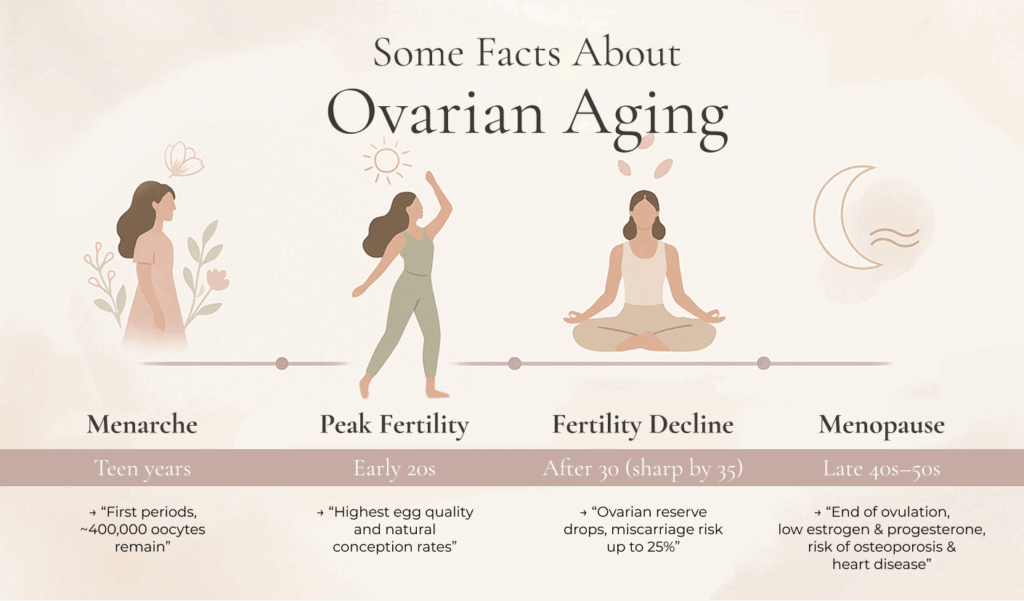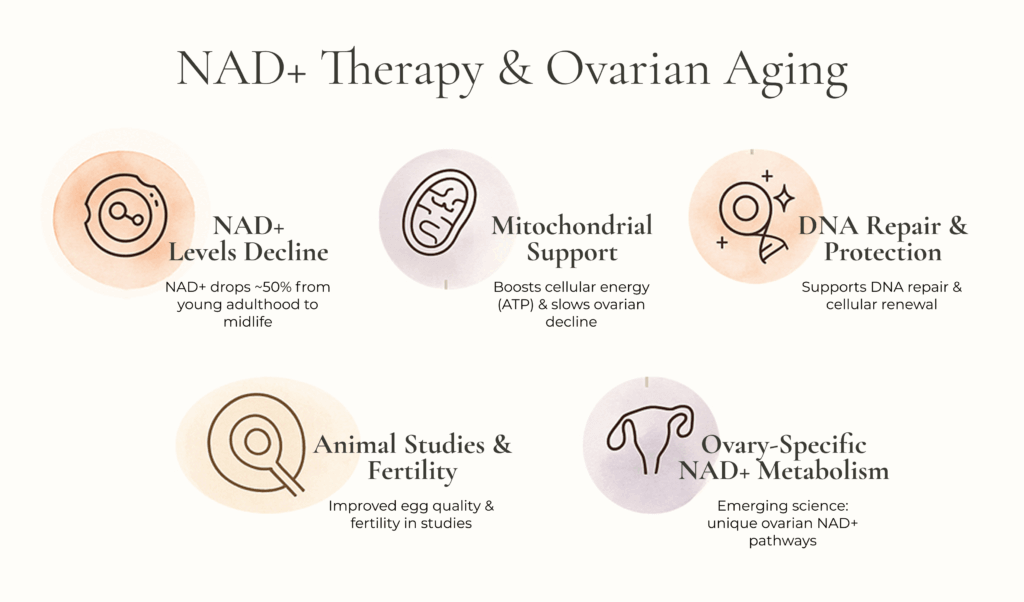
In medical circles, pregnancy over the age of 35 is labeled “geriatric,” implying that the mother is elderly in terms of obstetric risks. But that label is being challenged by demographic changes that extend the childbearing years into the 40s and beyond. According to one research article, nearly 15 per cent of all births now occur in women over age 35, accounting for 10% of all first-time births.
Nevertheless, postponing childbirth brings with it a unique set of risks and challenges, affecting all aspects of pregnancy from conception to delivery. Among them, aging ovaries pose a key challenge to conceiving a healthy child and carrying your pregnancy to term. But scientists are raising hopes among older moms with new research on the effect of NAD+ therapy on ovarian aging.
Some Facts About Ovarian Aging
In human females, fertility begins with menarche – a teenage girl’s first period – and monthly ovulation continues until menopause in late middle age. Women are born with up to 2 million oocytes (eggs), but by puberty, the number decreases to about 300,000-400,000. Human fertility reaches its peak in the early 20s, when a woman has the greatest number of high-quality eggs.
Ovarian aging refers to the gradual decline in ovarian function, primarily affecting female fertility and hormone production. Over the course of a woman’s reproductive years, only about 400-500 eggs are ovulated, while the remainder degenerate. Fertility begins to decline after age 30, with a dramatic drop by age 35 due to a reduced ovarian reserve and poorer egg quality. At that point, the chance of conception drops significantly while the chance of miscarriage increases by up to 25%. After age 40, as egg quality degenerates, chances of natural conception drop sharply.
As ovaries age, hormone production of estrogen and progesterone decreases, while follicle-stimulating hormone (FSH) rises, bringing on signs of menopause such as irregular menstrual cycles, poor sleep quality and hot flashes. Diminishing estrogen levels increase risks of osteoporosis, cardiovascular disease, and cognitive decline post-menopause. If conception does take place, aging eggs carry a higher risk of chromosomal abnormalities and conditions like Down syndrome.

At the same time, factors like smoking, obesity, stress, and exposure to environmental toxins can accelerate ovarian aging, and some women experience premature symptoms before age 40.
Biological Challenges of Postponing Childbirth
Social and cultural trends, along with advancements in technology, have pushed the average age of first pregnancy from the early 20s throughout most of human history, to the late 20s by the end of the late 20th Century, up to the 2020s. Factors like delayed marriage, improved contraception, increased economic opportunities for women, and changing social norms have all been influential.
But postponing childbirth comes with certain biological risks, such as:
- Declining fertility and difficulty conceiving.
- Increased risk of complications during pregnancy, including preeclampsia, gestational diabetes and miscarriage.
- Increased risk of chromosomal abnormalities in the baby.
- More complications during delivery, with increased risk of C-section.
- Premature birth and low birth weight.

It is worth noting that fertility also declines in men as they age, affecting sperm count, concentration and motility, and impeding the ability to achieve and maintain an erection. Older couples spend tens of thousands of dollars on fertility alternatives like in vitro fertilization (IVF), requiring high doses of fertility drugs and hormones. But IVF success rates for women aged 38-40 is only about 27%, dropping to roughly 9% for women over age 40, according to the CDC..
How NAD+ Therapy May Slow Ovarian Aging
Nicotinamide adenine dinucleotide (NAD+) is a critical coenzyme found in every human cell. While your body manufactures its own NAD+ from dietary precursors, NAD+ levels dramatically decline over time, dropping by about 50% from young adulthood to middle age. In recent years, NAD+ has been extensively researched for its anti-aging properties, including its effects on ovarian aging.
The antiaging properties of NAD+ are strongly linked to mitochondrial function. Mitochondria are cellular organelles where fats and carbohydrates are converted to ATP, the energy molecule. NAD+ is also responsible for DNA repair and neogenesis. Mitochondrial decline and DNA degeneration are both recognised as key factors in ovarian aging.

An extensive 2024 research article delves deeply into the mechanisms by which NAD+ combats and even reverses multiple markers of aging, including ovarian aging. The article cites animal studies where supplementation of NAD+ precursors in aging subjects significantly improved oocyte quality and enhanced fertility. While the precise mechanisms by which NAD+ reverses ovarian aging are not yet clear, the researchers were enthusiastically optimistic about the potential for NAD+ to improve fertility in women who postpone childbirth.
Another study published in 2023 affirms that mitochondrial dysfunction and oxidative stress are pivotal factors in ovarian aging, and that supplementation with NAD+ precursors is shown to support healthy mitochondrial function associated with ovarian health. A 2025 research article suggests that the ovary possesses its own unique NAD+ metabolism, although the understanding of its regulatory mechanisms is still in its infancy.
Lifestyle Factors that Enhance Female Fertility
Women postponing childbirth beyond their reproductive prime have a better chance of conceiving a healthy baby and carrying it to term if they take steps to optimize their health. Trying to conceive while combatting metabolic disorders or dealing with chronic stress can set you up for failure and heartache.
Lifestyle factors that accelerate ovarian aging and reduce fertility include:
- Smoking and tobacco use
- Excessive alcohol consumption
- Nutrient poor diet high in sugar and processed foods
- Obesity
- Lack of physical activity, causing mitochondrial shrinkage
- Overexercising and being underweight
- Chronic stress
- Exposure to pollutants and environmental toxins
- Poor sleep habits
- Excessive caffeine consumption
- Recreational and prescription drug use
Making positive lifestyle changes months prior to attempting to conceive can dramatically increase your chances of success while optimizing your overall health and that of your baby.
NAD+ IV Therapy for Anti-Aging Support in NYC
Extensive scientific research indicates that NAD+ IV therapy may provide a convenient and affordable way to combat aging and support reproductive health. When combined with a nutrient-dense diet, ample sleep, exercise, and stress management strategies, NAD+ is an evidence-based solution that can potentially help you live a longer, healthier life. Because NAD+ precursors are nutrients and not drugs, you don’t need a medical prescription to leverage their benefits, and there are no harmful side effects.
At Invita Wellness NYC, our professional staff carefully screens clients before administering NAD+ therapy. When delivered via IV infusion, NAD+ therapy delivers precursors directly to your bloodstream, bypassing your digestive tract where supplements often lose their potency. Each session lasts about an hour while you recline comfortably in a spa-like setting.
It’s never too late to combat aging and optimize your health. Contact Invita Wellness today, and unleash the anti-aging properties of NAD+.
Resources
Cordone, Valeria, et al. “Is NAD+ a key factor in ovarian aging and dysfunction? Insights and uncertainties from current research.” Biology of Reproduction (2025): ioaf140.
Is NAD+ a key factor in ovarian aging and dysfunction? Insights and uncertainties from current research
Jindal, Umesh N. “Mid-life fertility: Challenges & policy planning.” Indian Journal of Medical Research 148.Suppl 1 (2018): S15-S26.
https://pmc.ncbi.nlm.nih.gov/articles/PMC6469367
Kaur, K. K., G. N. Allahbadia, and M. Singh. “Exciting Hope for Professional Women Marrying Late–Manipulating NAD+ Metabolism: A Bright Future Prospect-A Narrative Review.” Chronicles of Clinical Reviews and Case Reports (2024): 1-30
https://www.researchgate.net/profile/Kulvinder-Kochar-Kaur/publication/384190051_Chronicles_of_Clinical_Reviews_and_Case_Reports_Exciting_Hope_for_Professional_Women_Marrying_Late_-Manipulating_NAD_Metabolism_A_Bright_Future_Prospect_-A_Narrative_Review/
Liang, Jinghui, et al. “Impact of NAD+ metabolism on ovarian aging.” Immunity & Ageing 20.1 (2023): 70.
Impact of NAD+ metabolism on ovarian aging